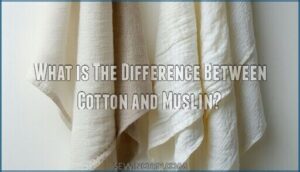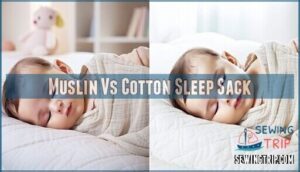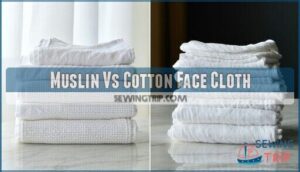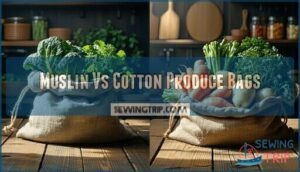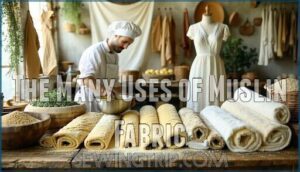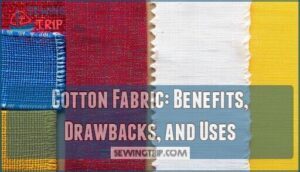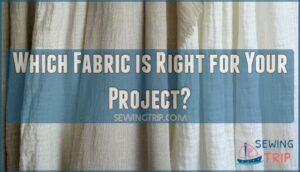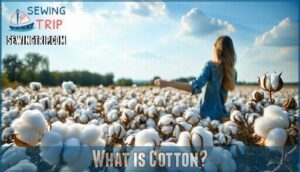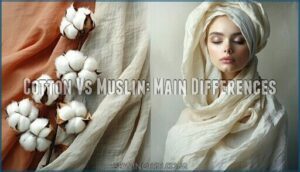This site is supported by our readers. We may earn a commission, at no cost to you, if you purchase through links.
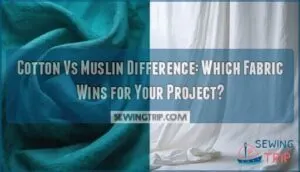 You’re comparing apples to oranges when you think about the cotton vs muslin difference.
You’re comparing apples to oranges when you think about the cotton vs muslin difference.
Cotton is the raw fiber, while muslin is a specific cotton fabric with a loose, plain weave.
Think of cotton as the ingredient and muslin as one recipe made from it.
Muslin’s loose weave makes it lighter and more breathable than standard cotton fabrics, which use tighter weaves.
You’ll find muslin softer and more delicate, perfect for baby items or photography backdrops.
Regular cotton fabrics are stronger and more durable for everyday use.
The weave structure determines everything from feel to function in your projects, making muslin and cotton distinct choices based on their unique properties.
Table Of Contents
- Key Takeaways
- Is Muslin Cotton?
- What is The Difference Between Cotton and Muslin?
- Muslin Vs Cotton for Baby
- Muslin Vs Cotton Backdrop
- Muslin Vs Cotton Sleep Sack
- Muslin Vs Cotton Face Cloth
- Muslin Vs Cotton Produce Bags
- The Many Uses of Muslin Fabric
- Cotton Fabric: Benefits, Drawbacks, and Uses
- Which Fabric is Right for Your Project?
- What is Cotton?
- What is Muslin?
- Cotton Vs Muslin: Main Differences
- Frequently Asked Questions (FAQs)
- Conclusion
Key Takeaways
- You’re comparing fiber to fabric – Cotton is the raw material, while muslin is a specific type of cotton fabric with a loose, plain weave that makes it lighter and more breathable than regular cotton fabrics.
- Muslin wins for baby items and hot weather – Its superior breathability and gentle texture make it perfect for swaddles, sleep sacks, and summer clothing, while cotton’s durability suits everyday wear and heavy-duty projects.
- Thread count tells the story – Muslin typically has 100-180 threads per square inch, creating that airy feel, while cotton ranges from 150-400 threads per square inch for stronger, denser fabric.
- Care and cost differ significantly – Muslin needs gentler handling, fades faster, and costs less upfront, while cotton withstands frequent washing, resists wrinkles better, and offers better long-term value.
Is Muslin Cotton?
Here’s the question that trips up many fabric shoppers: is muslin actually cotton? The short answer is yes, but there’s more to the story.
Muslin is a specific type of cotton fabric with unique characteristics. While regular cotton encompasses dozens of varieties and weave types, muslin represents just one branch of the cotton family tree. Think of it like this – all muslin is cotton, but not all cotton is muslin.
All muslin is cotton, but not all cotton is muslin – it’s like saying all roses are flowers, but not all flowers are roses.
The key lies in fiber processing and weave types. Muslin origins trace back to ancient Bengal, where craftspeople developed this distinctive plain-weave technique. Today’s muslin fabric uses cotton fibers woven in a loose, breathable structure that creates its signature lightweight feel.
Unlike heavier cotton varieties or complex fabric blends, muslin maintains cotton’s natural properties while offering superior breathability. This cotton vs muslin distinction matters when choosing materials for your next project.
What is The Difference Between Cotton and Muslin?
You’ll find that cotton is a fiber type while muslin is a specific fabric made with a loose, plain weave structure.
The key differences lie in their weave patterns, thread counts, how they behave when you wash and wear them, and their intended uses in your projects, particularly focusing on complete concepts.
Characteristics of The Weave
The weave makes all the difference between these fabrics.
Cotton comes in various weave patterns – plain, twill, or knit – while muslin sticks to a simple plain weave.
This cotton vs muslin distinction affects everything, giving muslin that signature drape quality and surface texture that feels airy and soft, due to its loose thread interlocking which creates lower weave density.
Count of Threads
Thread count defines how many threads fit into one square inch of fabric, directly impacting your project’s feel and performance.
Here’s what you need to know:
- Thread Count Defined: Cotton fabric typically ranges from 150-400 threads per square inch
- Muslin Thread Count: Usually sits between 100-180 threads per square inch
- Cotton Thread Count: Higher counts create smoother, denser fabric
- Thread Count Impact: Lower counts mean more breathable, lightweight material
The relationship between thread count and fabric properties is crucial for determining the suitability of a fabric for a particular project.
Behavior
Cotton and muslin behave differently when you wash and wear them.
Cotton properties include better wrinkle resistance and color retention, while muslin properties show higher water absorption and faster drying.
However, muslin’s shrinkage behavior can be unpredictable, and its fading tendencies mean colors wash out quickly.
This fabric comparison reveals muslin’s delicate nature versus cotton’s durability.
Muslin is available in types like breathable gauze muslin, offering different textures and uses.
Treatment and Use
Beyond their structural differences, how you treat and use these fabrics matters for your project’s success.
Here’s what you need to know:
- Dyeing Muslin works beautifully due to its loose weave and natural absorption
- Pre-Treatment Methods differ – cotton needs more prep while muslin accepts color easily
- Blending Fabrics requires understanding each material’s shrinkage and care needs
Cotton uses span heavy-duty applications, while muslin uses focus on delicate work.
Both benefit from Sustainable Practices in fabric care.
Muslin Vs Cotton for Baby
Baby’s skin deserves the gentlest touch, making your swaddling choice critical. Muslin wins for newborns thanks to its superior breathability factor and ultra-soft weave.
Regular cotton feels heavier against delicate skin, while muslin’s loose structure allows air to flow freely around your little one. For absorbency needs, both fabrics perform well, but muslin’s natural fibers excel at moisture-wicking without feeling damp.
You’ll find muslin baby blankets and baby items cost slightly more than cotton alternatives, yet the comfort difference justifies the investment. Considering its gentle nature, muslin is ideal for various baby products.
| Factor | Cotton | Muslin |
|---|---|---|
| Weight | Medium-heavy | Feather-light |
| Breathability | Good | Excellent |
| Gentleness | Moderate | Superior |
Smart parents choose muslin for swaddles, burp cloths, and receiving blankets. Your baby will thank you for prioritizing comfort over cost comparison considerations.
Muslin Vs Cotton Backdrop
Photography backdrops can make or break your shoot, and choosing between cotton and muslin matters more than you’d think.
Muslin’s loose weave creates stunning lighting effects by diffusing harsh studio lights naturally. Cotton fabric offers superior backdrop durability but reflects light differently, potentially affecting your color accuracy.
Both materials require different accessories, but you’ll need backdrop supports for either material.
| Feature | Muslin | Cotton |
|---|---|---|
| Wrinkle Resistance | Wrinkles easily, needs steaming | More wrinkle-resistant |
| Cost Comparison | Budget-friendly, reusable | Higher initial cost |
| Light Diffusion | Excellent light softening | Can create harsh reflections |
Muslin’s non-reflective surface delivers true color rendition, while cotton backdrops might introduce unwanted glare.
For photographers prioritizing natural lighting effects and cost-effectiveness, muslin wins. However, if you need something that travels well without constant ironing, cotton’s your friend.
Muslin Vs Cotton Sleep Sack
Choosing the right sleep sack fabric affects your baby’s comfort and safety throughout the night.
Muslin sleep sacks offer superior temperature regulation thanks to their loose, breathable weave.
This cotton fabric keeps little ones cooler during warm nights, reducing overheating risks.
Cotton sleep sacks provide more durability and absorbency.
| Feature | Muslin | Cotton |
|---|---|---|
| Breathability | Excellent airflow | Moderate airflow |
| Weight | Ultra-lightweight | Heavier feel |
| Softness | Gets softer with washing | Varies by quality |
Cotton sleep sacks withstand frequent washing better than delicate muslin.
However, muslin’s gentle touch against sensitive skin makes it ideal for swaddling benefits and baby safety.
Parents often find a muslin sleep sack ideal for infants.
Cost comparison reveals muslin typically costs less upfront, though cotton lasts longer.
For ease of cleaning, both work well in cold water.
Muslin requires gentle care – low heat drying prevents shrinkage.
Cotton handles higher temperatures.
Your choice depends on priorities: breathability and softness versus durability and absorption.
Muslin Vs Cotton Face Cloth
When choosing face cloths for delicate skin, you’ll find notable differences between cotton and muslin fabric options.
- Open Weave
- Lightweight Threads
- Sheer Drape
Muslin face cloths offer superior breathability with their loose weave structure, making them gentler for skin sensitivity concerns. Cotton fabric provides better durability but may feel rougher during exfoliation comparison tests.
Given its versatility, muslin is also often used for test garment creation.
| Feature | Muslin | Cotton |
|---|---|---|
| Absorbency Levels | Moderate absorption | High absorption |
| Drying Time | Quick-dry properties | Slower drying |
| Cost Analysis | Budget-friendly option | Slightly more expensive |
Muslin’s lightweight threads create a softer touch, while cotton offers stronger scrubbing power. Your choice depends on whether you prioritize gentleness or cleaning effectiveness for your skincare routine.
Muslin Vs Cotton Produce Bags
Three key factors make the difference when choosing between muslin and cotton produce bags for your kitchen needs. Your choice depends on what you’re storing and how often you’ll wash them.
Here’s how they compare:
| Feature | Muslin | Cotton |
|---|---|---|
| Breathability | Excellent airflow | Good ventilation |
| Durability | Moderate strength | High durability |
| Cost | Budget-friendly | Very affordable |
| Washing impacts | Gentle care needed | Machine wash friendly |
| Food storage suitability | Perfect for delicate items | Great for heavy produce |
Muslin’s loose weave creates superior breathability, keeping your fruits and vegetables fresher longer. Cotton’s tighter construction offers better durability for heavy items like potatoes or onions. Both serve as excellent reusable alternatives to plastic bags.
For those seeking reusable storage options, muslin bags are a great choice. For cost analysis, cotton typically wins on price, but muslin’s breathability comparison shows it excels at preserving delicate produce. You can’t go wrong mixing both types in your sustainable shopping routine.
The Many Uses of Muslin Fabric
Muslin fabric serves countless purposes beyond basic sewing.
You’ll find surgical muslin in hospitals for medical procedures, while chefs use it for culinary uses like straining stocks and making cheese.
Craft projects benefit from muslin’s affordable price and paint-friendly surface.
Theatre backdrops rely on this versatile fabric for stage sets. Historical garments often feature muslin’s authentic texture.
From baby swaddles to photography backdrop setups, this lightweight fabric adapts to almost any creative need you have, making it a valuable resource for various applications, including culinary uses.
Cotton Fabric: Benefits, Drawbacks, and Uses
You’ll find cotton fabric offers impressive versatility with its range of weights, weaves, and finishes that work for everything from lightweight summer shirts to heavy-duty denim.
Understanding cotton’s specific advantages and limitations helps you choose the right type for your project’s durability, comfort, and care requirements.
Benefits
Cotton brings impressive advantages that make it a go-to choice for countless projects.
You’ll appreciate its natural comfort and practical benefits.
- Breathability – Cotton’s weave allows air circulation, keeping you cool
- Softness – Gentle texture feels comfortable against sensitive skin
- Durability – Strong fibers withstand regular use and washing
- Versatility – Works for clothing, bedding, crafts, and home décor
- Cost effectiveness – Quality fabric at reasonable prices with minimal environmental impact
Drawbacks
Despite cotton’s popularity, you’ll face several challenges.
Cotton shrinkage affects sizing after washing, while fabric fraying occurs along cut edges.
Cotton cost varies substantially based on quality grades.
The material shows fiber weakening over time, plus fabric stress from repeated washing cycles.
| Drawback | Impact Level | Solution |
|---|---|---|
| Cotton shrinkage | High | Pre-wash fabric |
| Fabric fraying | Medium | Finish seam edges |
| Cotton cost | Variable | Compare quality grades |
| Fiber weakening | Gradual | Gentle wash cycles |
| Fabric durability concerns | Long-term | Choose higher thread counts |
Uses
You’ll find cotton everywhere in your daily life.
Fashion design relies on cotton for durable clothing like t-shirts and jeans.
Home decor projects benefit from cotton’s versatility in curtains and upholstery.
Industrial purposes demand cotton’s strength for work clothes.
Meanwhile, muslin serves surgical needs with its gentle touch.
Quilting backing and photography backdrop applications showcase muslin’s specialized fabric uses for baby items, highlighting the importance of versatility.
Which Fabric is Right for Your Project?
Your project’s success depends on choosing the right fabric based on your specific needs and goals.
Consider factors like durability requirements, breathability preferences, and how the fabric will work with other materials you’re using, including the importance of breathability.
What Look Are You Going For?
Your desired aesthetic shapes everything about fabric selection.
Picture your project vision – do you want structured elegance or flowing softness? Cotton fabric offers crisp lines and defined shapes, while muslin fabric creates dreamy, relaxed silhouettes.
Consider these texture preferences for visual impact:
- Structured projects: Cotton canvas provides sharp edges and durability
- Flowing designs: Muslin’s loose weave creates beautiful fabric drape
- Mixed textures: Combine both for contrast and depth
Match fabric characteristics to your creative goals for the best results.
What Other Fabrics Are You Working With?
Mixing different fabrics in your project requires careful planning.
Consider how cotton and muslin interact with other materials.
Fabric blends affect dye compatibility – muslin absorbs color differently than dense cotton fabric.
Sewing difficulty increases when combining lightweight muslin with heavier materials.
Project durability depends on matching fabric weights appropriately.
Cost comparison matters when selecting complementary fabrics.
Pair breathable muslin with structured cotton for interesting contrasts, but verify similar care requirements for long-lasting results.
This approach ensures that the final product has the desired look and feel, with careful planning being essential to its success.
What is Cotton?
You’ll find cotton in nearly everything from your favorite t-shirt to your bed sheets because it’s one of the world’s most versatile natural fibers.
This plant-based material comes from cotton bolls and can be woven into fabrics ranging from lightweight voiles to heavy denim depending on your project needs, making cotton a highly useful material.
Uses of Cotton
Cotton dominates clothing applications from comfortable t-shirts to sturdy jeans.
You’ll find it throughout home textiles like soft bed linens, towels, and curtains.
Industrial uses include canvas and rope manufacturing.
Medical purposes rely on cotton’s absorbent properties for bandages and surgical materials.
Cotton composites strengthen automotive parts, while home decor benefits from its versatility and durability.
Pros of Cotton
Beyond its widespread applications, cotton fabric delivers impressive benefits that make it a favorite among sewers and manufacturers alike.
This natural fiber combines practicality with performance in ways that keep it relevant across countless projects.
Here’s what makes cotton shine:
- Durability – Cotton weave withstands repeated washing and daily wear
- Versatility – Works for everything from t-shirts to home décor
- Comfort – Cotton softness feels gentle against sensitive skin
- Availability – Found everywhere from craft stores to high-end retailers
- Cost-effectiveness – Affordable pricing fits most budgets without sacrificing cotton breathability
Cons of Cotton
Despite its popularity, cotton comes with several drawbacks that might surprise you.
Here’s what you need to know about cotton’s limitations:
- Shrinkage Issues – Cotton fabrics can shrink up to 5% even in cold water, turning your perfectly fitted sheets into ill-fitting disappointments.
- Wrinkling Tendency – Without proper care, cotton emerges from the dryer looking like it’s been crumpled in a ball, requiring time-consuming ironing.
- Environmental Impact – Cotton production uses massive amounts of water and pesticides, making it less eco-friendly than you’d expect.
- Cost Variation – Quality cotton can be expensive, while cheaper options often lack durability and comfort.
Cotton’s breathable fibers feel wonderful initially, but frequent washing leads to pilling, fading colors, and fabric deterioration.
Some people also experience allergen potential with certain cotton treatments.
Pre-shrunk or blended cotton varieties can minimize these issues, but they won’t eliminate them entirely.
What is Muslin?
You’ve probably touched muslin fabric without knowing its name – it’s that lightweight, loosely woven cotton material that feels soft and slightly rough at the same time.
This plain-weave fabric comes from cotton fibers that aren’t heavily processed, which gives muslin its natural, breathable texture that’s perfect for hot weather and test garments.
Uses of Muslin
Muslin fabric serves countless purposes beyond baby care.
You’ll find it wrapping cheese during aging, protecting delicate plants from harsh weather, and serving surgical applications in medical settings.
Artists use muslin for art restoration projects, while photographers rely on it for backdrops.
In culinary uses, muslin strains broths and filters ingredients.
| Application | Purpose | Benefits |
|---|---|---|
| Baby Items | Swaddles, burp cloths, blankets | Breathable, gentle on skin |
| Photography | Studio backdrops, diffusion screens | Even lighting, wrinkle-resistant |
| Medical/Surgical | Bandages, gauze, surgical prep | Sterile, absorbent, disposable |
| Culinary | Cheese making, straining liquids | Food-safe, fine filtration |
Muslin is used in various fields, including medical settings, due to its breathable and absorbent properties.
Pros of Muslin
You’ll love how muslin fabric brings together comfort and practicality in one breathable fabric.
This affordable option delivers exceptional muslin breathability while maintaining natural drape that feels gentle against skin.
- Breathable Fabric: Open weave allows air circulation, keeping you cool
- Soft Texture: Muslin softness improves with each wash cycle
- Versatile Uses: Perfect for clothing, crafts, and home projects
- Affordable Option: Budget-friendly choice without sacrificing quality
Cons of Muslin
While muslin offers wonderful breathability, it comes with notable durability issues.
You’ll find it’s less colorfast than regular cotton, fading quickly after washing.
Muslin also wrinkles easily and has limited versatility due to its delicate nature.
The loose weave means fraying and shrinking are common problems.
Over time, you’ll notice texture changes that affect the fabric’s original strength and overall durability.
Cotton Vs Muslin: Main Differences
When you’re choosing between cotton fabric and muslin, understanding their core differences helps you pick the winner for your project.
Cotton’s tighter weave density provides durability, while muslin’s loose muslin weave creates that signature soft drape.
Muslin is often favored for projects like backdrops and test garments, but linen offers alternatives with unique benefits.
| Feature | Cotton | Muslin |
|---|---|---|
| Weave Density | Tight, structured | Loose, breathable |
| Fiber Processing | More refined | Less processed |
| Absorbency Levels | Higher absorption | Moderate absorption |
| Climate Suitability | All seasons | Hot, humid weather |
| Cost Comparison | Mid-range pricing | Budget-friendly |
Cotton withstands frequent washing and offers superior absorbency levels, making it perfect for towels and everyday wear.
Muslin’s minimal fiber processing gives it that delicate texture ideal for baby items.
Climate suitability varies too – cotton works year-round while muslin excels in summer heat.
Frequently Asked Questions (FAQs)
Is muslin cotton better than cotton?
Like comparing apples to apple pie, you’re looking at ingredient versus product.
Muslin is a specific type of cotton fabric with looser weave and lighter weight, making it more breathable but less durable than regular cotton.
What is the disadvantage of muslin?
You’ll find muslin’s main drawbacks include poor durability and quick fading.
It’s less colorfast than regular cotton, tears easily, and requires gentler handling.
The loose weave also makes it unsuitable for heavy-duty projects.
Is all muslin 100% cotton?
Thinking you’ve discovered fabric’s Holy Grail? Not so fast.
While most muslin is 100% cotton, you’ll find blends with silk, linen, or synthetic fibers.
Check labels carefully—manufacturers often mix materials for different textures and strengths.
What is special about muslin fabric?
Muslin’s loose weave and lightweight structure make it incredibly breathable and comfortable.
You’ll love how it softens with each wash, drapes beautifully, and works perfectly for test garments and hot weather clothing.
How do I care for cotton and muslin fabrics?
Wash both fabrics in cold water with mild detergent to prevent shrinking.
Air dry when possible, as heat damages fibers.
Iron on medium heat while slightly damp for best results and longevity.
What are some common projects for using cotton and muslin fabrics?
Like using a telegraph instead of email, you’ll find cotton perfect for sturdy everyday items like t-shirts, jeans, and bed linens.
While muslin works best for test garments, quilting backings, and delicate baby clothes.
Where can I buy high-quality cotton and muslin fabrics?
You’ll find high-quality cotton and muslin fabrics at specialty fabric stores.
Online retailers like Fabric.com or Mood Fabrics, craft stores such as Jo-Ann’s, and local quilting shops offering premium selections.
What are the environmental impacts of cotton and muslin production?
Picture Earth as a thirsty giant – cotton production drinks massive amounts of water and uses heavy pesticides.
You’ll find both fabrics share similar environmental footprints since most muslin comes from cotton fibers.
How much do cotton and muslin fabrics typically cost?
Muslin typically costs less than regular cotton, making it budget-friendly for testing garments and craft projects.
Cotton prices vary widely based on quality and processing, from affordable basics to premium options, with complete concepts of pricing being a key factor.
Can muslin fabric be machine washed safely?
Yes, you can safely machine wash muslin fabric on a gentle cycle with cold water.
Use mild detergent and avoid bleach.
Expect some shrinkage and wrinkles, so air-dry or use low heat settings.
Conclusion
Imagine this: choosing fabric is like picking the right tool for a job.
Understanding the cotton vs muslin difference guarantees you’ll select wisely every time.
Cotton delivers durability and versatility for everyday projects, while muslin offers delicate breathability perfect for babies and photography.
You’ve learned that muslin’s loose weave creates its signature softness, whereas cotton’s tighter construction provides strength.
Now you can confidently match each fabric’s unique properties to your specific needs, creating projects that truly succeed.
- https://www.theweebean.com/blogs/news/muslin-clothing-guide?srsltid=AfmBOoqKKXxPYEwpFxeR6LtukEFW6WC6XBod6y8-06_w3zA2GsPbXLYt
- https://thefabricfox.co.uk/blog/quilting-cotton-vs-muslin-which-fabric-is-better-for-quilting/?srsltid=AfmBOoq_3lDhRGMhzyJpScMr_EOkYftP3MqY0yTpkdtC7mX5Y2TNeKcG
- https://www.sourceoffabric.com/difference-between-cotton-and-muslin/
- https://www.quiltersreview.com/muslin-vs-cotton/
- https://www.cvlinens.com/blogs/styling-tips/what-is-the-difference-between-cotton-gauze-and-cotton-muslin?srsltid=AfmBOopFIJm0Vi-qA6x0VjAvR_eV6EhT-PiWnVRUOmBOtEzxhfNXJa4X

